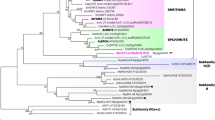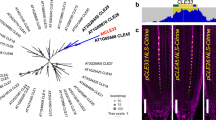Abstract
Mutations in TOO MANY MOUTHS (TMM), which encodes a receptor-like protein, cause stomatal patterning defects in Arabidopsis leaves but eliminate stomatal formation in stems. Stomatal development in wild-type and tmm stems was analyzed to define TMM function. Epidermal cells in young tmm stems underwent many asymmetric divisions characteristic of entry into the stomatal pathway. The resulting precursor cells, meristemoids, appropriately expressed cell fate markers such as pTMM:GFP. However, instead of progressing developmentally by forming a guard mother cell, the meristemoids arrested, dedifferentiated, and enlarged. Thus asymmetric divisions are necessary but not sufficient for stomatal formation in stems, and TMM promotes the fate and developmental progression of early precursor cells. Comparable developmental and mature stomatal phenotypes were also found in tmm hypocotyls and in the proximal flower stalk. TMM is also a positive regulator of meristemoid division in leaves suggesting that TMM generally promotes meristemoid activity. Our results are consistent with a model in which TMM interacts with other proteins to modulate precursor cell fate and progression in an organ and domain-specific manner. Finally, the consistent presence of a small number of dedifferentiated meristemoids in mature wild-type stems suggests that precursor cell arrest is a normal feature of Arabidopsis stem development.







Similar content being viewed by others
Abbreviations
- ER:
-
ERECTA
- ERL1:
-
ERECTA-LIKE1
- ERL2:
-
ERECTA-LIKE2
- GFP:
-
Green fluorescent protein
- GL2:
-
GLABRA2
- GMC:
-
Guard mother cell
- TMM:
-
TOO MANY MOUTHS
References
Berger F, Linstead P, Dolan L, Haseloff J (1998) Stomata patterning on the hypocotyl of Arabidopsis thaliana is controlled by genes involved in the control of root epidermis patterning. Dev Biol 194:226–234
Bergmann DC, Sack FD (2007) Stomatal development. Annu Rev Plant Biol 58:163–181
Bergmann DC, Lukowitz W, Somerville CR (2004) Stomatal development and pattern controlled by a MAPKK kinase. Science 304:1494–1497
Boetsch J, Chin J, Croxdale J (1995) Arrest of stomatal initials in Tradescantia is linked to the proximity of neighboring stomata and results in the arrested initials acquiring properties of epidermal cells. Dev Biol 168:28–38
Chin J, Wan Y, Smith J, Croxdale J (1995) Linear aggregations of stomata and epidermal cells in Tradescantia leaves: evidence for their group patterning as a function of the cell cycle. Dev Biol 168:39–46
Croxdale JL (2000) Stomatal patterning in angiosperms. Am J Bot 87:1069–1080
Cutler SR, Ehrhardt DW, Griffitts JS, Somerville C (2000) Random GFP::cDNA fusions enable visualization of subcellular structures in cells of Arabidopsis at high frequency. Proc Natl Acad Sci USA 97:3718–3723
Geisler M, Sack FD (2002) Variable timing of developmental progression in the stomatal pathway in Arabidopsis cotyledons. New Phytol 153:469–476
Geisler M, Yang M, Sack FD (1998) Divergent regulation of stomatal initiation and patterning in organ and suborgan regions of the Arabidopsis mutants too many mouths and four lips. Planta 205:522–530
Geisler M, Nadeau J, Sack FD (2000) Oriented asymmetric divisions that generate the stomatal spacing pattern in Arabidopsis are disrupted by the too many mouths mutation. Plant Cell 12:2075–2086
Hara K, Kajita R, Torii KU, Bergmann DC, Kakimoto T (2007) The secretory peptide gene EPF1 enforces the stomatal one-cell-spacing rule. Genes Dev 21:1720–1725
Hung CY, Lin Y, Zhang M, Pollock S, Marks MD, Schiefelbein J (1998) A common position-dependent mechanism controls cell-type patterning and GLABRA2 regulation in the root and hypocotyl epidermis of Arabidopsis. Plant Physiol 117:73–84
Kagan ML, Novoplansky N, Sachs T (1992) Variable cell lineages form the functional pea epidermis. Ann Bot 69:303–312
Kono A, Umeda-Hara C, Adachi S, Nagata N, Konomi M, Nakagawa T, Uchimiya H, Umeda M (2007) The Arabidopsis D-type cyclin CYCD4 controls cell division in the stomatal lineage of the hypocotyl epidermis. Plant Cell 19:1265–1277
Lai L, Nadeau JA, Lucas J, Lee E-K, Nakagawa T, Zhao L, Geisler MJ, Sack FD (2005) The Arabidopsis R2R3 MYB proteins FOUR LIPS and MYB88 restrict divisions late in the stomatal cell lineage. Plant Cell 17:2754–2767
Larkin JC, Marks MD, Nadeau J, Sack F (1997) Epidermal cell fate and patterning in leaves. Plant Cell 9:1109–1120
Larkin JC, Brown ML, Schiefelbein J (2003) How do cells know what they want to be when they grow up? Lessons from epidermal patterning in Arabidopsis. Annu Rev Plant Biol 54:403–430
Lucas JR, Nadeau JA, Sack FD (2006) Microtubule arrays and Arabidopsis stomatal development. J Exp Bot 57:71–79
Nadeau JA, Sack FD (2002a) Control of stomatal distribution on the Arabidopsis leaf surface. Science 296:1697–1700
Nadeau JA, Sack FD (2002b) Stomatal development in Arabidopsis. In: Somerville CR, Meyerowitz EM (eds) The Arabidopsis book. American Society of Plant Biologists, Rockville. doi: 10.1199/tab.0066
Pillitteri LJ, Torii KU (2007) Breaking the silence: three bHLH proteins direct cell-fate decisions during stomatal development. Bioessays 29:861–870
Pillitteri LJ, Sloan DB, Bogenschutz NL, Torii KU (2007) Termination of asymmetric cell division and differentiation of stomata. Nature 445:501–505
Pillitteri LJ, Bogenschutz NL, Torii KU (2008) The bHLH protein, MUTE, controls differentiation of stomata and the hydathode pore in Arabidopsis. Plant Cell Physiol 49:934–943
Sachs T (1991) Pattern formation in plant tissues. Cambridge University Press, New York
Sachs T, Novoplansky N, Kagan M (1993) Variable development and cellular patterning in the epidermis of Ruscus. Ann Bot 71:237–243
Serna L, Torres-Contreras J, Fenoll C (2002) Clonal analysis of stomatal development and patterning in Arabidopsis leaves. Dev Biol 241:24–33
Shpak ED, McAbee JM, Pillitteri LJ, Torii KU (2005) Stomatal patterning and differentiation by synergistic interactions of receptor kinases. Science 309:290–293
von Groll U, Berger D, Altmann T (2002) The subtilisin-like serine protease SDD1 mediates cell-to-cell signaling during Arabidopsis stomatal development. Plant Cell 14:1527–39
Wang H, Ngwenyama N, Liu Y, Walker JC, Zhang S (2007) Stomatal development and patterning are regulated by environmentally responsive mitogen-activated protein kinases in Arabidopsis. Plant Cell 19:63–73
Yang M, Sack FD (1995) The too many mouths and four lips mutations affect stomatal production in Arabidopsis. Plant Cell 7:2227–2239
Acknowledgments
Thanks to Dave Deppong (BASF, N. Carolina, USA) for identifying stable transformants of pKAT::GFP, to Rebecca Lamb (Ohio State University, USA) for many helpful discussions, and to the Arabidopsis Biological Resource Center at Ohio State University for supplying insertional mutant lines. This work was supported in part by the U.S. National Science Foundation.
Author information
Authors and Affiliations
Corresponding author
Rights and permissions
About this article
Cite this article
Bhave, N.S., Veley, K.M., Nadeau, J.A. et al. TOO MANY MOUTHS promotes cell fate progression in stomatal development of Arabidopsis stems. Planta 229, 357–367 (2009). https://doi.org/10.1007/s00425-008-0835-9
Received:
Accepted:
Published:
Issue Date:
DOI: https://doi.org/10.1007/s00425-008-0835-9




